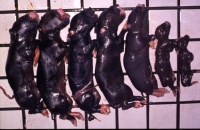Difference between revisions of "Japanese Encephalitis Virus"
| (8 intermediate revisions by 2 users not shown) | |||
| Line 1: | Line 1: | ||
| − | |||
Also Known As: '''''JE — Japanese B Encephalitis — Hydrancephaly — JEV — JE Virus''''' | Also Known As: '''''JE — Japanese B Encephalitis — Hydrancephaly — JEV — JE Virus''''' | ||
==Introduction== | ==Introduction== | ||
| + | [[File:JEV Litter.jpg|thumb|200px|right|Litter from a JEV infected sow showing two mummified piglets. Copyright CFSPH Iowa State]] | ||
Japanese Encephalitis is caused by a '''[[Culicidae|mosquitoe-borne]] [[Flaviviridae|flavivirus]]''' and affects a wide range of species including ruminants, carnivores, birds and humans. | Japanese Encephalitis is caused by a '''[[Culicidae|mosquitoe-borne]] [[Flaviviridae|flavivirus]]''' and affects a wide range of species including ruminants, carnivores, birds and humans. | ||
| − | It is best known for causing reproductive failure in sows and central nervous system disease in horses | + | It is best known for causing reproductive failure in sows and central nervous system disease in horses. |
This disease is '''notifiable''' to the World Organisation for Animal Health [http://www.oie.int/ (OIE)] | This disease is '''notifiable''' to the World Organisation for Animal Health [http://www.oie.int/ (OIE)] | ||
| Line 40: | Line 40: | ||
==Control== | ==Control== | ||
| − | '''Live attenuated vaccines''' are available against JEV | + | '''Live attenuated vaccines''' are available against JEV. |
Fly control is valuable but impractical. | Fly control is valuable but impractical. | ||
| Line 48: | Line 48: | ||
|flashcards = [[Japanese Encephalitis Flashcards]] | |flashcards = [[Japanese Encephalitis Flashcards]] | ||
}} | }} | ||
| + | |||
==References== | ==References== | ||
<references/> | <references/> | ||
| − | + | Animal Health & Production Compendium, '''Japanese encephalitis virus datasheet''', accessed 06/06/2011 @ http://www.cabi.org/ahpc/ | |
| − | |||
| − | |||
| − | |||
| − | |||
| − | |||
| − | + | Animal Health & ProductIon Compendium, '''Japanese encephalitis datasheet''', accessed 06/06/2011 @ http://www.cabi.org/ahpc/ | |
| − | |||
| − | |||
| + | {{review}} | ||
[[Category:Flaviviridae]] | [[Category:Flaviviridae]] | ||
[[Category:Zoonoses]] | [[Category:Zoonoses]] | ||
| Line 68: | Line 63: | ||
[[Category:Reproductive Diseases - Pig]][[Category:Neurological Diseases - Horse]] | [[Category:Reproductive Diseases - Pig]][[Category:Neurological Diseases - Horse]] | ||
| − | [[Category:CABI Expert Review | + | [[Category:CABI Expert Review]] |
| − | |||
Revision as of 22:43, 19 June 2011
Also Known As: JE — Japanese B Encephalitis — Hydrancephaly — JEV — JE Virus
Introduction
Japanese Encephalitis is caused by a mosquitoe-borne flavivirus and affects a wide range of species including ruminants, carnivores, birds and humans.
It is best known for causing reproductive failure in sows and central nervous system disease in horses.
This disease is notifiable to the World Organisation for Animal Health (OIE)
JE is zoonotic, epidemics having been recorded in Japan, Korea and India during the mosquito season. Although disease is usually mild or subclinical, fatal encephalitis can develop in children.
Distribution
JE has a number of insect vectors, mainly mosquitoes. Distribution is restricted to South-East Asia.
Birds, particularly herons, are maintenance hosts for JEV while pigs are amplifier hosts.
Clinical Signs
Key reproductive signs include abortion in pregnant sows, stillbirths, male infertility, lack of libido, small litter sizes and heat on palpation of the testes and scrotum.
Neurological disease in horses features trembling, ataxia, incoordination, opisthotonus, hypermetria, aggression and blindness.
Anorexia, inappetance and ill thrift often accompany other signs.
Infection is usually subclinical in other species.
Diagnosis
Antibody titres can be detected serologically by haemagglutination inhibition, ELISA, serum neutralisation and other methods. Antibodies can also be detected in foetuses.
Viral antigen can be demonstrated in brain, placenta and foetuses by indirect fluorescent staining (IFAT) and avidin-biotin staining.
On post-mortem of piglets from infected dams, hydrocephalus, hydrothorax, subcutaneous oedema and necrotic foci within the organs are common. The meninges and spinal cord may be congested and cerebellar hypomyelinogenesis has been described. [1]
In male infected pigs, large amounts of mucoid fluid are present within the tunica vaginalis and the epididymis and tunic are fibrosed.
Treatment
No treatment is available in animals.
Human recombinant interferon has been used in human cases of JEV.
Control
Live attenuated vaccines are available against JEV.
Fly control is valuable but impractical.
| Japanese Encephalitis Virus Learning Resources | |
|---|---|
 Test your knowledge using flashcard type questions |
Japanese Encephalitis Flashcards |
References
- ↑ Morimoto, T. (1969) Epizootic swine stillbirth caused by Japanese encephalitis virus. Proc symposium on factors producing embryonic and fetal abnormalities, death, and abortion in swine. US ARS, 91-73:137-153
Animal Health & Production Compendium, Japanese encephalitis virus datasheet, accessed 06/06/2011 @ http://www.cabi.org/ahpc/
Animal Health & ProductIon Compendium, Japanese encephalitis datasheet, accessed 06/06/2011 @ http://www.cabi.org/ahpc/
| This article has been peer reviewed but is awaiting expert review. If you would like to help with this, please see more information about expert reviewing. |
